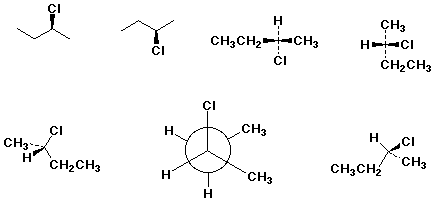
Chemistry 331 - Winter 1996
Elements of Organic Chemistry I

Professor Carl C. Wamser

EXAM 2
February 27, 1996
1. (15 points) Write complete names for each of the following, including
designation of stereochemistry.
a) 
b) 
c) 
2. (12 points) Complete each of the following reactions by adding the
missing part: either the necessary reagents and conditions, or the final
major product.
a) 
b)
c) 
d) 
3. (12 points) Circle all of the structures that correspond to (R)-2-chlorobutane.

4. (5 points) Identify with an asterisk (*) all of the stereogenic centers
in the structure shown below (R & S designations not necessary here).

Aspartame, an artificial sweetener (Equal)
5. (10 points) Identify as R or S each of the two stereogenic centers
in threonine, shown below. Add the missing substituents to the structure
on the right.

threonine, a naturally occurring amino acid
6. (14 points) Shown below are three alkene isomers labeled X, Y, and
Z. Also shown below are four alkyl bromide isomers labeled A, B, C, and
D.


Apply Markovnikov's Rule to predict the major product from addition of HBr
to each of the alkenes.
Apply Zaitsev's Rule to predict the major product of elimination from each
of the alkyl bromides.
7. (12 points) Complete the following reaction scheme by adding the
missing parts:

8. (20 points) Styrene, shown below, might react with a strong electrophile
in two distinct ways:

a) The electrophile might add to the aromatic ring. Show the intermediate
that would result from attack of E+ at the para position, including all
resonance forms.
b) The electrophile might add to the double bond. Show the intermediate
that would result from addition of E+ according to Markovnikov's Rule, including
all resonance forms.
c) Which do you think actually occurs? Explain your answer with a justification
of the relative likelihood of each possibility.
![]()
![]()
![]()













